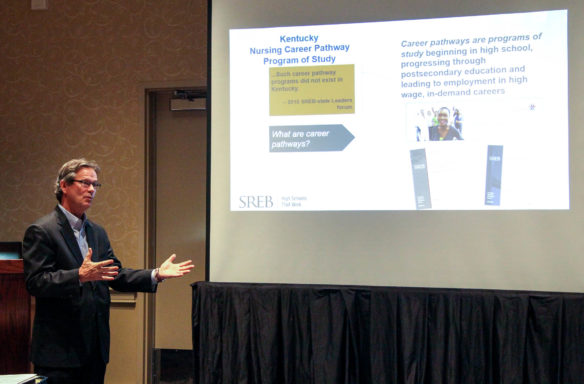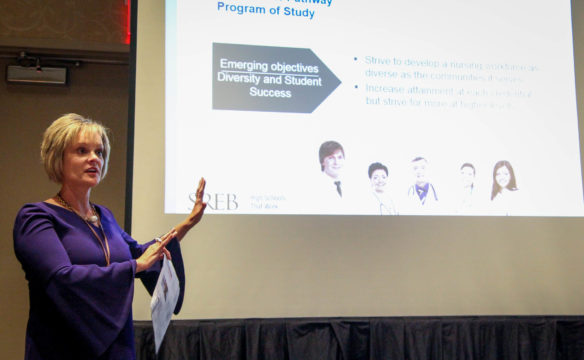
Tim Shaughnessy, developer of career pathway programs of study for the Southern Regional Education Board, worked with Laura Arnold, associate commissioner for Career and Technical Education for the Kentucky Department of Education, to create a streamlined pathway to help students earn a bachelor’s degree in nursing.
Photo by Brenna R. Kelly, Sept. 18, 2017.
By Brenna R. Kelly
Brenna.kelly@education.ky.gov
As a principal of the Marion County Area Technology Center, Laura Arnold recalled how each year the local newspaper’s tribute to high school graduates included each student’s picture and plans for after high school.
“If you took that newspaper two years later and looked at every one of those students to see where they were, some of them weren’t on that track,” said Arnold, now the Kentucky Department of Education’s (KDE) associate commissioner for career and technical education. “Some of us didn’t like to go back and look at that. I know I didn’t.”
But if high school students were able to begin working toward a bachelor’s degree and given a clear path to get there, they could have a better chance staying on track, she said.
That’s why KDE, along with the Southern Regional Education Board (SREB) and other partners, created a new nursing pathway designed to help students earn a bachelor’s degree in nursing faster, with lower costs and more opportunities to earn credentials along the way. A two-year pilot is underway.
“This isn’t a high school program, this isn’t a college program or an industry-driven program. This is a program that’s owned by everyone,” said Tim Shaughnessy, SREB’s developer of career pathway programs of study. “We want a program that is effective, something that students will succeed in. It had to be something that’s affordable and meets the needs of industry, with students who have the skill set to be hired.”
Nursing was chosen because the career offers a salary that can support a middle class lifestyle, is in high demand and has a high level of interest among students. The 2015 median annual wage for healthcare jobs nationally was $62,610, higher than the $36,200 median for all jobs, according to the U.S. Bureau of Labor Statistics, 2016. And in Kentucky interest in those jobs is high, students who take the ACT consistently choose a health field as their intended college major, Shaughnessy said.
Nursing also has a defined progression to a bachelor’s degree, starting with a certified nursing assistant, then a licensed practical nurse, a registered nurse and then a bachelor’s of science nursing.
“You have industry agreement in terms of what certifications are valued,” he said. “And you also have a very strong existing academic infrastructure to support those programs.”

Laura Arnold, associate commissioner for Career and Technical Education for the Kentucky Department of Education, said the new nursing pathway allows students to begin working toward a bachelor’s degree in high school and gives them a clear path to follow after high school.
Photo by Brenna R. Kelly, Sept. 18, 2017.
To make the pathway work, officials had to get buy-in from health care providers, the Kentucky Community and Technical College System and a four-year institution.
Officials with the Education and Workforce Cabinet, who worked with KDE and SREB on the plan, urged Arnold and Shaughnessy to start the program in Louisville, where nurses are in high demand and employers would be open to participating, Shaunghessy said. The group worked with Jefferson Community and Technical College and Spalding University as the postsecondary partners to offer the pathway
The new streamlined pathway allows students to earn a bachelor’s degree with 120 college credit hours at a cost of about $10,000, he said. Previously, students who earned an associate degree in nursing at KCTCS, accumulated an average of 116 credit hours although the degree only required 71. Students who attend a four-year nursing program at one of the state’s universities end up paying between $35,000 and $40,000. The pathway lowers the cost because many of the credit hours are obtained at the community college.
The pathway includes:
- 16-26 hours of dual credit in high school to become a certified nursing assistant;
- 30 hours at a community and technical college to become a licensed practical nurse;
- 30 hours at a community and technical college for an associate degree to become a registered nurse; and
- 30 hours taken online through Spalding University to complete a bachelor’s of science in nursing.
Employers have agreed to interview students who graduate from the program, Shaughnessy said.
“Students are not guaranteed a job, but if you go through this program you are guaranteed an interview and ideally that would lead to employment,” he said.
The pathway is designed for any student who wants to become a nurse. The dual credit high school classes include CTE classes, as well as academic classes such as math and English, she said.
The new nursing pathway was specifically designed to allow students easy entrance and exits points in case a student needs to work for a while before continuing his or her education.
“The neat thing about this program is that these students are getting credentials along the way, because life sometimes happens,” Arnold said. “But at least they have that credential so that they can get back on the pathway at another time.”
The pathway is being piloted at iLead Academy, the state’s first regional career academy designed to prepare students for the highest-demand, highest-wage jobs in the golden triangle region bordered by Louisville, Lexington and Northern Kentucky. The Carrollton-based academy serves five school districts and is operated by the Ohio Valley Education Cooperative.
Sixteen iLead students are enrolled now in the two-year pilot, said iLead Director Larisa McKinney. One student, a junior, already has become a nurse’s aide and is taking 15 hours at Jefferson Community and Technical College (JCTC). She also plans to take 15 hours in the spring, so she will graduate high school as a licensed practical nurse and could complete her associate degree over the summer with JCTC’s bridge program, McKinney said.
“This program is not for the faint of heart however,” McKinney said. “All of these high school students are completing serious college level curriculum that until recently has only been offered to juniors or seniors.”
In October, the Kentucky Board of Education approved a waiver from the defined set of courses laid out in Kentucky’s graduation requirements to allow students the flexibility needed for the pathway.
Arnold expects the pathway to be used across the state and that the department will develop similar pathways for other areas of study. One being considered is a global logistics pathway, she said.
“Even though we’re developing a statewide process, what we’ve got to remember is that it will look a little different depending on the region and the community because of the employers and the postsecondary partners that are involved,” she said.
Arnold urged schools and districts to begin thinking about how the nursing pathway or a similar pathway would work in their community.
“If you identify that there’s a need, people from KDE are more than willing to come and help facilitate conversations between you, employers and postsecondary on how do you develop these true seamless pathways from secondary to postsecondary to help the meet the workforce demand,” she said. “If employers see results, they are going to invest in you and your students because they see that as the pipeline.”
MORE INFO…
Laura Arnold Laura.Arnold@education.ky.gov
Tim Shaughnessy tim.shaughnessy@sreb.org
Larisa McKinney lmckinney@ovec.org



Leave A Comment